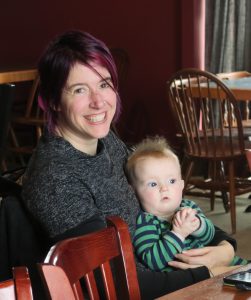 My friend and colleague, Guelph professor, Dr. Shoshanah Jacobs (left, with her new son) invited me to give a guest talk in her first year Biology course: Discovering Biodiversity. I introduced the bioblitz concept in my talk, and encouraged students to join in with one, or to even organize a bioblitz of their own.
My friend and colleague, Guelph professor, Dr. Shoshanah Jacobs (left, with her new son) invited me to give a guest talk in her first year Biology course: Discovering Biodiversity. I introduced the bioblitz concept in my talk, and encouraged students to join in with one, or to even organize a bioblitz of their own.
The general goal of a bioblitz is to get people excited about biodiversity. The idea is to bring together experts and amateurs to identify as many different species as possible, in a defined area, over a specific time period. The most common bioblitz format that I've experienced, runs over 24 hours, starting at 12 noon, and ending at noon the next day. This allows moths and bats to be counted. But, actually, a bioblitz can be whatever you want to make of it, and everyone, including novice citizen scientists interested in natural history can participate, because a bioblitz is, fundamentally, about NOTICING biodiversity. Obviously, professional biologists and experienced amateur naturalists are likely to notice more species than novices, but a bioblitz allows people with different backgrounds to get involved with nature.
Chickadees @yorkuniversity this AM, @YorkUBioBlitz.@ctehmeena just spotted a screech owl , @YorkUnews!#YorkU #Bioblitz #SciComm #scilit17 pic.twitter.com/vQ8GG0ZGgo
— Dawn Bazely (@dawnbazely) September 22, 2017
On Friday, September 22nd 2017, Biology graduate student Amanda Liczner, together with many other graduate students, including Tehmeena Chaudhry, Alex Filazzola, Shelby Gibson, Meagan Tompkins, and Arshad Imrit, organized a bioblitz on the Keele Campus. The YorkU bioblitz began with bird identification at 07:30am in the Boyer woodlot and ended at 4pm. Participants found a total of 126 taxonomic groups on our very urban campus in the Fall.
 Big Bioblitzes in Canada
Big Bioblitzes in Canada
In June 2017, I participated in my third Toronto bioblitz, which took me back to the Rouge River Watershed. This enormous Royal Ontario Museum-led citizen-science party first began in 2011. The 2015 Toronto bioblitz (left) took place at sites in the Don River Watershed.
Instead of identifying plant species, this year, I led three hikes, teaching novice citizen scientists the basics of identifying trees and flowers from field guides, like Newcomb's Wildflower Guide. Learning to use a flower or tree field guide is a great skill. Learning to distinguish a sugar maple from a silver or Norway maple, from a field guide is immensely satisfying, and I guarantee that everyone can learn to do this!

